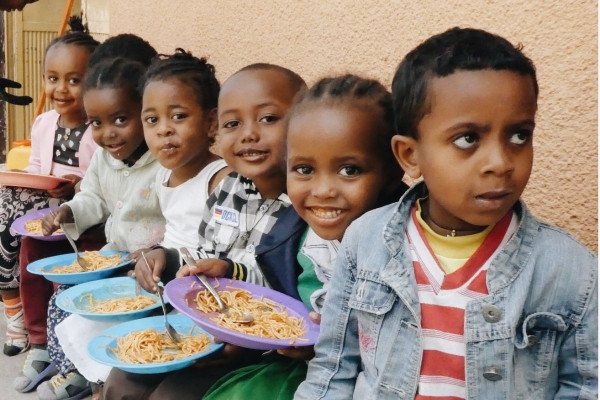SOCIAL ACCOUNTABILITY PROGRAM
Project: Social Accountability In five pro poor sectors at East Hararghe Zone, Harar region and Dire Dawa Administration
HFC has been undertaking several development projects with different partners since the past two decades. One of these is the Social Accountability Project. By creating closer relationships between service providers and the general public, increasing the number of responsible service providers; the changes in basic services had been brought by HFC clear and efficient project implementation system.
Citizens’ engagement with government to address service delivery issues had long been a challenge in Ethiopia. To encourage citizens to hold service providers more accountable, the Ethiopian government and VNG international (Association of Dutch Municipalities) launched the Ethiopia Social Accountability Program, which aimed to build on a pilot implemented from 2006 to 2009. The program partnered with civil society organizations across the country, which then worked with communities to assess and give feedback to public service providers, such as schools, FTC, roads, and healthcare centres.
By 2012 the second phase of social accountability project was launched and by 2019, the third phase of the program has been followed.
Since 2013, HFC initiated collaboration with Ethiopian social accountability program to accelerate and scale up the adoption of social accountability mechanisms in the water, education, health, rural road, agriculture and other supportive sectors through knowledge and programmatic activities involving citizens, Service provider, councils, government and relevant stakeholders.
What is Social Accountability?
Social accountability process involves engaging both service user and service providers (duty bearers) to assess policies and programs for improvement in service delivery. This process has been seen as a tool for promoting citizen assertiveness and government responsiveness in service provision.
Objective
The project development objective of ESAP is to support strengthening the Social Accountability (SA) system and mechanisms for enhanced service delivery in Ethiopia. Thus, the ultimate target is service improvement in any of the five basic sectors where ESAP is active, and where SA is considered a critical means to achieve this.
Specific Objective
The (specific) objective is to enhance the dialogue and feedback loop between basic service users and service providers on the quality and accessibility of services.
WHAT ARE SA OUTCOMES?
To come to the above objective, the programme has formulated five outcomes:
Outcome 1:Increased Awareness around Social Accountability and Citizen Mobilization
Intermediate outcome 1.1: Representatives of citizens and marginalized groups organized to participate in SA processes.
Intermediate outcome 1.2: Citizens are aware of service standards, entitlements and SA processes
Intermediate outcome 1.3: CSOs and other relevant actors (such as media) play a mobilization role between citizens and service providers to implement SA projects
Outcome 2: Services are Assessed by Citizens
Intermediate outcome 2.1: Citizens set their priorities through SA processes
Outcome 3: Citizens and service providers agree on a Joint Action Plan (JAP) for service improvements
Intermediate outcome 3.1: Interface meeting and JAP formulation
Outcome 4: JAPs are aligned with woreda planning and budgeting processes
Intermediate outcome 4.1: Citizens' role in budget planning and implementation reinforced
Intermediate outcome 4.2: CSOs and regional government work together (under the FTA-SA-GRM partnership) to resolve prioritized systemic woreda level issues
Outcome 5: Monitoring of JAP implementation and learning
Intermediate outcome 5.1: Citizens monitor implementation of joint action plans
Intermediate outcome 5.2: Evidence-based collaborative SA interventions and action research feeds into national policy making and practice
Intermediate outcome 5.3: National practice dissemination media channels and knowledge management portal established and functional
The specific component objectives are as follows:
Component 1: to extend and expand SA (tools and approaches) in kebeles and woredas through grants.
Component 2: to institutionalise SA in government institutions and systems through capacity development.
Component 3: to properly manage, coordinate and monitor the project
How does SA work?
The Social Accountability process knows five steps:
1) Access to information,
2) Assessment of services using Social Accountability Tools
3) Interface meetings,
4) Joint Action Plan implementation,
5) Monitoring.
Target Location
Hope for children organization are actively involved in 13 woredas in:
East Hararghe zone: Fedis, Haramaya, Awaday, Babile, Kersa and Meta Woredas
Harari region: Shenkor, Dire Teyara and Sofi Woreda
Dire Dawa administration: Biyo Awele, Wahil, Asaliso cluster and Dire Dawa town.
.
Social Accountability Tools
Five different tools are used to implement Social Accountability projects all over Ethiopia. These tools help to assess the quality of service delivery, and to monitor and evaluate a service improvement agenda as agreed between citizens and service providers in the interface meeting.
The most used Social Accountability tools are:
1) Community Score Card
2) Citizens Report Card
3) Participatory Planning and Budgeting
4) Public Expenditure Tracking Survey
5) Gender Responsive Budgeting
Community Score Card is a tool used by community members to evaluate their access to basic services and the quality of service they receive. It also includes a self-assessment of service delivery and performance by service providers. Access, quality and equity of basic service delivery are assessed using community developed performance indicators assisted by the grantees.
Citizens’ Report Cards are surveys that collect service users’ opinions on the performance of public service delivery. The opinions of different social and vulnerable groups are gathered to enable equitable service delivery.
Participatory Planning and Budgeting supports the direct participation of citizens and citizens groups in the budget formulation process of the Woreda, to influence the amount and priorities of budgets allocated to basic service delivery. Another approach to participatory budgeting is when the community suggests alternative budgets to influence budget formulation by expressing citizen preferences.
Public Expenditure Tracking Survey is a means to assess if the allocated budget for the provision of public services is actually spent as intended, to deliver quality services. By studying the transfer and use of funds and in kind resources, the Public Expenditure Tracking Survey provides a rigorous basis for citizens and citizen groups to engage in a dialogue with service providers and local government to improve budget execution for enhanced service delivery.
Gender Responsive Budgeting is a means of integrating a gender dimension into all steps of the budget process. This ensures that budget policies can take into consideration the gender dimension in society and can stop direct and indirect discrimination against either women or men. It is about taking into account the different needs and priorities of both women and men without gender exclusivity. Gender Responsive Budgeting ensures that budgets are gender sensitive, not gender neutral.
Results of Social Accountability
Achievements of the social accountability program in last year’s:
- Above 8,100 citizen groups have been trained
- Above 4,600 service provider and government have been officials trained
- The shortage of drugs, doctors, and support staff in health centres and hospitals has been addressed.
- A new health centre has been built
- Schools are built and the existing schools have been renovated.
- A desk was purchased for a number of students who were sitting on the floor before.
- Computer class has been opened in several schools
- Toilets have been built in schools
More information on Social accountability project
You can subscribe to ESAP 3 newsletter onESAP 3 website:www.esap2.org.et
Life skill project
This project initiated to capacitate OVC in life skill development to create self-awareness, self-esteem, self-sufficient and problem solving practices among OVC
Youth Enrichment Center
a center where OVC get access to various small scale vocational skills ,trainings that includes computer, hand craft, sewing, basketry, language and drawing skills. With this project thousand of community children benefited and their educational as well as interpersonal communications developed. They got an access to different trainings and skills by professional trainers.
Group Home Care
This is a project designed to provide care to OVC through family-like home environment of group home. We have 20 years profound experience managing group homes. As the result hundreds of OVC benefited and become productive citizen by this project. At a time we were managing 12 group homes having 120 children so far. But, due to house rent increment and other factors we reduced the group homes time to time.
© Copyright 2024 Hope For Children Organization Lotus Software Solutions by Lotus Software Solutions



